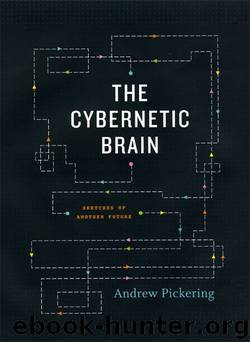The Cybernetic Brain: Sketches of Another Future by Pickering Andrew

Author:Pickering, Andrew [Pickering, Andrew]
Language: eng
Format: epub
Publisher: University of Chicago Press - A
Published: 2011-01-15T00:00:00+00:00
Figure 6.16.The cybernetics of crisis. Source: S. Beer, Brain of the Firm, 2nd ed. (New York: Wiley, 1981), 354, fig. 48.S.
Little more can be said here—this book is not a treatise on recent world history—but I do want to note that Beer's "cybernetics of crisis" included an analysis of how crises like the present one can arise. Again, Beer's focus was on transformative flows of information. Figure 6.16 is his basic diagram for considering such processes: the hatched area denotes a crisis affecting three different interest groups, which might be nation-states, A, B, and C. The details are less important than Beer's general analysis of the information flow from the crisis region into A ("sensory input") and the return action of Aon the crisis ("motor output"). What Beer emphasized was that such information flows necessarily impoverish variety, and that in a systematic way. His argument was that representations of crises are inevitably filtered through lowvariety conceptual models, models through which governments interpret crises to themselves and the media interpret them to the public. These models then feed into a low variety of potential actions which return to intensify the variety of the crisis along axes that are unrepresentable in the models, and so on around the loop.
Let me close this section with three comments. First, we can note that this last discussion of the role of models in the production of crises is of a piece with Beer's general suspicion of articulated knowledge and representation. Models might be useful in performance, as in the VSM, but they can also interpose themselves between us and the world of performances, blocking relevant variety (hence the significance of the inarticulacy of Beer's algedonic meters, for example). Second, Beer died before the invasion of Iraq; the above thoughts on that are mine, not his. But, again, I am struck now not by any self-serving quality of his rhetoric, but by the prescience of his analysis. The highly simplifed story of information flows and variety reduction that I just rehearsed illuminates how global politics could have collapsed so quickly into one-bit discriminations (Beer 1993a, 33) between "us" and "them," the goodies and the baddies; how it could have been that a majority of the American population could believe there was some connection between Al Qaeda and Iraq prior to the invasion and in the existence of what we were taught to call "weapons of mass destruction"; how it is that the American public and, perhaps, their government could have expected the invaders to be greeted with flowers and kisses rather than car bombs; and (turning back to the question of controlling variety) why mayhem should have been expected instead. Of course, third, one does not have to be Stafford Beer or a cybernetician to be critical of the war on terror, a "war" in which, "allies are expected to go into battle against an abstract noun, and to assault any nation unwilling to mobilize in such folly" (S. Beer 2001, 862–63). What interests me, though, is the generality of Beer's cybernetic analysis.
Download
This site does not store any files on its server. We only index and link to content provided by other sites. Please contact the content providers to delete copyright contents if any and email us, we'll remove relevant links or contents immediately.
| AI & Machine Learning | Bioinformatics |
| Computer Simulation | Cybernetics |
| Human-Computer Interaction | Information Theory |
| Robotics | Systems Analysis & Design |
Algorithms of the Intelligent Web by Haralambos Marmanis;Dmitry Babenko(9832)
Test-Driven Development with Java by Alan Mellor(7651)
Data Augmentation with Python by Duc Haba(7536)
Principles of Data Fabric by Sonia Mezzetta(7312)
Learn Blender Simulations the Right Way by Stephen Pearson(7230)
Microservices with Spring Boot 3 and Spring Cloud by Magnus Larsson(7063)
RPA Solution Architect's Handbook by Sachin Sahgal(6455)
Jquery UI in Action : Master the concepts Of Jquery UI: A Step By Step Approach by ANMOL GOYAL(6447)
The Infinite Retina by Robert Scoble Irena Cronin(6165)
Hadoop in Practice by Alex Holmes(6136)
Big Data Analysis with Python by Ivan Marin(5883)
Life 3.0: Being Human in the Age of Artificial Intelligence by Tegmark Max(5474)
Pretrain Vision and Large Language Models in Python by Emily Webber(4840)
Infrastructure as Code for Beginners by Russ McKendrick(4621)
WordPress Plugin Development Cookbook by Yannick Lefebvre(4341)
Functional Programming in JavaScript by Mantyla Dan(4216)
The Age of Surveillance Capitalism by Shoshana Zuboff(4209)
Embracing Microservices Design by Ovais Mehboob Ahmed Khan Nabil Siddiqui and Timothy Oleson(4112)
Applied Machine Learning for Healthcare and Life Sciences Using AWS by Ujjwal Ratan(4090)
